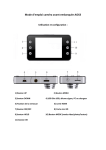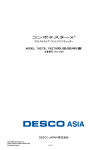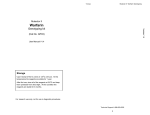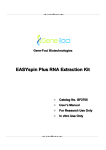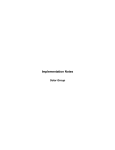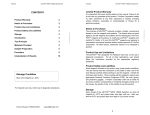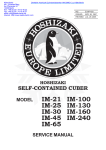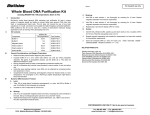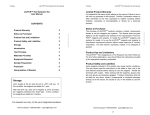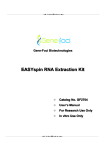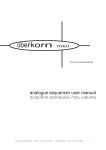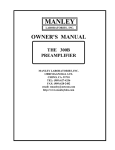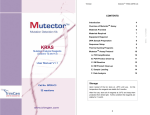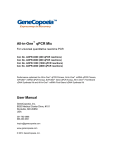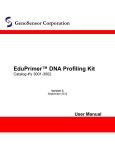Download Manual - Trimgen
Transcript
TM TrimGen Corporation WaxFree RNA User Manual Limited Product Warranty It is imperative that the users strictly adhere to this manual. Failure to do so will void TrimGen's guarantee of this product. TrimGen Corporation makes no other warranties of any kind, expressed or implied, including without limitation, warranties of merchantability or fitness for a particular purpose. CONTENTS 3 Frequently Asked Questions 4 Kit Contents 5 Materials and Equipment Needed 5 Standard Protocol 6 Short Protocol 9 Notice to Purchaser The product is provided as “Research Use Only, Not for use in diagnostic procedures”. The purchaser must determine the suitability of the product for their particular use. The purchase of WaxFreeTM RNA products includes a limited, nonexclusive license to use the kit and systems. This license does not grant rights to use the kit and systems for reproduction of the WaxFreeTM RNA kit and systems, to modify the WaxFreeTM RNA kit TM and systems for resale, or to use the WaxFree RNA kit and systems to manufacture commercial products without written approval of TrimGen Corporation. No other license, expressed, implied or by estoppels is granted. Product Safety and Liabilities Downstream Applications 10 When working with the kit reagents, always wear a suitable lab coat, disposable gloves, and protective goggles. TrimGen Corporation shall not be liable for any direct, indirect, consequential or incidental damages arising out of the misuse, the results of use, or the inability to use this product. Storage: Upon receipt, store the kit at 2-8°C. Shelf Life Storage options Shelf life Kits stored at 2-8°C 6 months Enzyme Mix stored at –20°C All other components stored at 2-8°C 1 year 2 V2 90522 Introduction TM TrimGen Corporation WaxFree RNA User Manual TM TrimGen Corporation Introduction WaxFree RNA User Manual Frequently Asked Questions WaxFreeTM RNA kit is designed to extract RNA from 1. 2. 3. 4. Q: Can I use the kit to extract RNA from old paraffin sample? Formalin fixed, paraffin-embedded (FFPE) tissue Fine needle aspiration (FNA) samples Fresh or frozen tissue Cells Q: Can I use the kit to extract DNA? A: Yes. The final extract includes RNA and DNA from tissue. Q: Can I amplify 300bp product from the RNA sample? A: No. The RNA in the paraffin sample is already partially degraded during formalin fixation. The average size of RNA is about 100-120 bp. The kit uses Q-Solution, a non-toxic solution to efficiently remove paraffin and formalin residual from tissue. Q: Can I design the PCR primers in same exon? The WaxFreeTM RNA kit can be used with the Standard Protocol or Short Protocol. The applications for each protocol are listed in the table below: A: No. If the PCR primers are located in same exon, it could amplify the genomic DNA instead of RNA because most RNA extraction methods have DNA contamination. To avoid the artificial DNA amplification, you should design the forward primer in one exon and the reverse primer in next exon. Tissue Type Standard Protocol Short Protocol FFPE Slides FFPE sections in tube Recommended Tissue dissected from paraffin slide or block Fine needle aspiration (FNA) sample Fresh or frozen tissues Culture cells 3 4 V2 90522 V2 90522 WaxFreeTM RNA kit is a homogenous extraction method, which eliminates RNA loss inherant in traditional column, beads and phenol-chloroform extraction methods. The R-resin and the enzyme mix are optimized to maximally release RNA from tissues to increase the yield of RNA. The extracted RNA from one paraffin section (size 1 x 1cm, 10µm thickness) is sufficient to perform up to 15 RT-PCR reactions. A: Yes. We successfully extracted RNA from 10 year old paraffin sample and the RT-PCR results were excellent. TM TrimGen Corporation WaxFree RNA User Manual TM TrimGen Corporation WaxFree RNA User Manual Kit Contents Standard Protocol The kit provides extraction reagents for 50 samples. Pre-heat a heat block or incubator to 45oC. Set another heat block to 90oC. Component Quantity Wash Buffer 60 ml Enzyme Mix 0.5 ml R-Resin 7.5 ml WR-Filter 50 1. Collect 1.5 or 2 ml tubes (screw cap) and label the tubes with sample ID. 2. Collect sample Paraffin section on slide: One section with tissue size 1-2 cm2 and 5-20 µm thickness. Scrape the tissue from slide and transfer to a tube. Paraffin section prepared in tube: directly go to step 3. Paraffin tissue block: Trim away surrounding paraffin. Cut and transfer 10-30mg of tissue to a tube. Fine needle aspiration sample: transfer entire sample to a tube. Materials and Equipment Needed 2ml sterile screw-cap microcentrifuge tubes For solid tissue with high cell density such as brain or liver, reduce the amount of tissue for extraction. Laboratory incubator Heat Block (1-2) Vortex Mixer 3. Add 0.8 ml of Q-Solution to each tube. Microcentrifuge 4. Screw cap on and vortex for 30 seconds at high speed. 70% Ethanol (optional for Standard Protocol ONLY) 5. Incubate the tube at 45°C for 20 minutes. RNase-Free DNase I is not included in the kit. The enzyme can be purchased separately from TrimGen (Cat. No. DE-50), or from other vendors. 6. Vortex the tube 30 seconds at high speed. 7. Centrifuge the tube at 10,000 x g (about 12,000-14,000 rpm in most tabletop centrifuge) for 10 minutes. 8. Discard the supernatant using a pipettor or by aspiration. Be careful not to disturb the tissue pellet. 9. Add 1 ml of Wash Buffer to the tube. 10. Screw cap on and vortex 10 seconds at high speed to resuspend the pellet. 5 6 V2 90522 50 ml V2 90522 Q-Solution TM TrimGen Corporation WaxFree RNA User Manual 11. Centrifuge the tube at 10,000 x g (about 12,000-14,000 rpm in most tabletop centrifuge) for 10 minutes. RNA User Manual X White filter White filter 14. Cap the tube and vortex 10 seconds at high speed. 20. After incubation, transfer the entire extraction mix to WRfilter. 15. Incubate the tube at 90°C for 10 minutes, then cool the tube to room temperature 20-25°C. 21. Centrifuge the tube at 1,000 x g (about 1500-3,000 rpm in most tabletop centrifuge) for 3 minutes. 16. Add 7 µl (3.5 µl for small paraffin tissue or FAN sample) of Enzyme Mix to each tube. Cap the tube and mix the content by flicking the tube. 22. Discard the WR-Filter. The solution in the tube is the final extract, which contains RNA ready for reverse transcription reaction or one-step RT-PCR. For multiple samples Prepare pre-mixed R-Resin with Enzyme Mix using formula below: Note: Storage of RNA is not recommended even at – 80°C. The extracted RNA should be converted to cDNA after extraction. The cDNA can be stored at –20°C. R-Resin = Sample # x 120 (60 for small tissue) x 1.1 Enzyme Mix = Sample # x 7 (3.5 for small tissue) x 1.1 23. RNA Concentration Measurement: see page 11. Transfer 127µl (63µl for small size tissue) of the mixture to each tube. Return the Enzyme Mix to -20°C for storage. 17. Incubate the tube at 45°C for 1 hour. 18. Heat the tube at 90°C for 10 minutes. 7 8 V2 90522 V2 90522 The step 14 and 15 are designed for skin or muscle tissues only, for other type of tissues go to step 16. WaxFree 19. Place WR-Filter into a 1.5 ml tube and label the tube with sample ID. Make sure the white filter is at the bottom of the column (see below) 12. Discard the supernatant using a pipettor or by aspiration. Be careful not to disturb the pellet. 13. Re-suspend R-Resin thoroughly by shacking the bottle several times. Transfer 120 µl (60 µl for small paraffin tissue or FAN sample) of the R-Resin to each tube. TM TrimGen Corporation TM TrimGen Corporation WaxFree RNA User Manual Pre-heat a heat block or incubator to 45oC. Set another heat block to 90oC. Enzyme Mix (µl) 120 7 FFPE on slide < 0.5 cm 60 3.5 FNA 60 3.5 Fresh tissue 10-30 mg 120 7 Fresh tissue < 10 mg 60 3.5 5 120 60 7 3.5 FFPE on slide 0.5-2 cm2 2 Cells > 10 – 10 Cell < 105 8 Fresh or frozen tissues: Cut and transfer 10-30mg tissues to a tube. For multiple samples Culture cells: Transfer 100 µl cell suspension (103-106 cells) to a 2 ml tube. Prepare pre-mixed R-Resin with Enzyme Mix using formula below: For solid tissue with high cell density such as brain or liver, reduce the amount of tissue for extraction. R-Resin = Sample # x 120 (60 for small tissue) x 1.1 Enzyme Mix = Sample # x 7 (3.5 for small tissue) x 1.1 Blank control: If you are planning to measure the RNA concentration after the extraction, you need to set up a Blank Control tube. Add an extra tube to Step 2 and process it as a sample, but without adding any tissue. This tube is the Blank Control for OD260/280 calibration. Transfer 127µl (63µl for small size tissue) of the mixture to each tube. 5. Screw cap on and mix the content by flicking the tube. 3. Re-suspend the R-Resin by thoroughly shaking the bottle several times. Then, transfer 120µl* of the R-Resin to each tube (for small size tissue add 60µl, see table 1). 6. Incubate the tube at 45°C for 1 hour. 7. Heat the tube at 90°C for 10 minutes. Return the Enzyme Mix to -20°C. 9 10 V2 90522 Fine needle aspiration sample: transfer entire sample to a tube. R-Resin (µl) Tissues Size V2 90522 Paraffin tissue block: Trim away surrounding paraffin. Cut and transfer 10-30 mg of tissue to a tube. RNA User Manual *Table 1 1. Collect 1.5 or 2 ml tubes(screw cap) and label the tubes with the sample ID. Paraffin section on slide: One section with tissue size 1-2 cm2 and 5-20µm thicknesses. Scrape the tissue from slide and transfer to a tube. WaxFree 4. Add 7 µl* of Enzyme Mix to each tube. (for small size tissue add 3.5µl, see table 1). Short Protocol 2. Collect sample TM TrimGen Corporation TM TrimGen Corporation WaxFree RNA User Manual Aliquot 5µl of final extract to new tube. Dilute the final extract with 45µl water. Calibrate the UV spectrophotometer using the diluted Blank Control and adjust the OD260 and OD280 to zero to remove any background absorbance caused by the reagents. Then, measure the diluted samples at OD260/280 to calculate the RNA concentration. The following equation can be used to determine the concentration of the extracted RNA. A convenient calculation form is available online: 9. After incubation, transfer the extraction mix to WR-filter. 10. Place the WR-Filter in a new tube and centrifuge the tube at 1,000 x g (about 1,500-3,000 rpm in most tabletop centrifuge) for 3 minutes. www.trimgen.com/wf/DNA-calculation.xls RNA Conc. (ng/µl) = (62.9 x OD260 – 36 x OD280) x dilution factor / 0.5 RNA Quality 11. Discard the WR-Filter. The solution in the tube is the final extract, which contains RNA ready for reverse transcription reaction or one-step RT-PCR. Note: Storage of RNA is not recommended even at –80°C. The extracted RNA should be converted to cDNA after extraction. The cDNA can be stored at –20°C. WaxFreeTM is a homogeneous extraction method. The proteins from tissue remain in the final extracts and cause a reduction in the OD ratio. A typical OD260/280 ratio ranges from 0.8 to 1.3. The low OD ratio will not affect the reverse transcription or RT-PCR. Measure by fluorescent method The RNA concentration can be accurately measured by RiboGreen® method (Invitrogen, Cat. No. R-R-32700). http://probes.invitrogen.com/media/pis/mp32700.pdf 11 12 V2 90522 White filter RNA User Manual Measure by OD260 method V2 90522 White filter WaxFree RNA Concentration Measurement: 8. Place WR-Filter into 1.5 ml tubes and label the tubes with sample ID. Make sure the white filter is at the bottom of the column (see below): X TM TrimGen Corporation TM TrimGen Corporation WaxFree RNA User Manual TM TrimGen Corporation Downstream Applications WaxFree RNA User Manual Troubleshooting Guide (Reagents are not included in this kit) Problem Suggestions Reverse transcription The removal of paraffin is Too much tissue sample incomplete WaxFreeTM RNA standard protocol is optimized for a maximum of 3 FFPE sections (5-20 µm thick, up to a 3 cm2 each). PCR amplification Trim off excess paraffin before extraction. The PCR enzyme and condition varies in different laboratories. Before starting routine operation, we recommend that the first time user perform a sample titration test to find a proper sample amount for your PCR amplification. As an example, use 5µl, 10µl, 15µl of RT products for 25µl PCR reactions to determine the best sample volume for PCR. The forward and reverse PCR primers should be designed in different exons to prevent the artificial amplification of genomic DNA. For larger sections reduce the number of sections used for extraction Add more Q-solution for deparaffinization. The final RNA extract has yellow or brown color, the RT-PCR does not work well The paraffin samples such as bone marrow, spleen, and liver contains high blood component. The hemoglobin in the sample is the cause of the color and also inhibits the RT or PCR reaction. It is necessary to remove these molecules by further purification using a spin column (TrimGen, Spin 50 Cat No. TC-50) or other commercial RNA purification kit. The OD260/280 ratio is below our QC criteria, can I use the extracted RNA for RT-PCR Yes. The RNA quality assessment is different from conventional extraction methods. A typical OD260/280 ratio for the WaxFreeTM ranges from 0.6 to 1.5. The low OD ratio will not affect the RT-PCR reaction. For special applications such as a microarray study, further purification may necessary. The OD 260 is too high Need Blank Control tube Use the Blank control tube to calibrate the spectrophotometer, then measure One-Step RT-PCR Use 5 - 10 µl of the final extraction supernatant as a template for total 50 µl of One-step RT-PCR reaction. Sample normalization for quantitative PCR The OD 260 absorbance of final extraction can be used as a reference to normalize the difference between samples. 13 14 V2 90522 V2 90522 Use 10-25µl of the final extracts as template for total 50µl of reverse transcription reaction. The reverse transcribed cDNA can be stored at –20°C. TM TrimGen Corporation WaxFree RNA User Manual the OD. Some of the R-resin are leaking to the collection tube. For larger size tissue sections, or solid tissues with high cell density, the final RNA extract needs to be diluted with water. Yes. You need to spin the collection tube at 10,000 x g to bring down the R-resin and then use the supernatant. Can I use the final extract Check your centrifuge to reduce the to perform the RT-PCR? spin speed to 1,000 x g. Less RNA released For some tissues such as skin and muscle, the 1-hour enzyme digestion is not long enough to extract RNA efficiently from these tissues. Increasing the enzyme digestion time to 3 hours or overnight at 45°C will increase the yield of RNA. The RNA concentration calculated from the OD260/280 readings is high and RT-PCR does not work. RNA concentration is too high: Dilute the extraction supernatant with nuclease- free water then perform the RT-PCR. PCR amplicon size is too big The formalin fixation will damage RNA. The average size of RNA in the FFPE sample is about 100-150 bp. When the designed amplicon size is too big, the PCR may not work because the genome RNA in the FFPE tissue already broken. The RNA quality depends on the tissue type, storage time, and fixation conditions. Our customers have successfully amplified 150 bp PCR products from 10-year-old samples. 15 RNA User Manual V2 90522 The RNA concentration is low Add more final extract to the RT-PCR reaction. However, the excess of final extract may inhibit the RT-PCR reaction. It is necessary to titrate the final extract for the RT-PCR reaction. WaxFree V2 90522 The RNA concentration calculated from the OD260/280 readings is low and the RT-PCR does not amplify properly TM TrimGen Corporation 16








